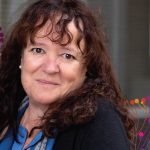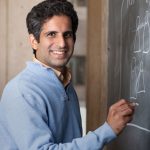Observations Margarita Behrens Master of brain circuits
Research Professor Margarita Behrens was born in Uruguay but moved to Chile at a young age. She was one of six girls born to two chemists. Behrens grew up with a passion for understanding the relationship between structure and function and was torn between becoming an architect and a scientist. She ultimately decided to pursue biochemistry in college and graduate school. At Salk, Behrens applies her biochemistry training to better understand how neurons develop in the brain. Her findings have implications for neurodevelopmental disorders, such as schizophrenia and autism.
Inside Salk sat down with Behrens to learn about her work to understand neural circuit formation and disruption, as well as her love of architecture.
When did you know you wanted to be a neuroscientist?
MB: I was always fascinated by the brain. When I was in school, the brain was still considered a black box. Psychiatrists would talk about it as this black box on the outside, and neurologists would talk about when it breaks down on the inside. But to me, mental disorders spanned this boundary between the two, where the brain looked physically normal but was not acting normal. This disparity captured my fascination and drove me to pursue neuroscience. Although I must admit that another love of mine was architecture.
What interested you about architecture?
MB: I studied architecture for a year and a half prior to pursuing science. I had thought I wanted to be an architect since I was 10 years old. I just loved it. But during school, I suddenly realized that I would get bored pursuing it for the rest of my life. I love a challenge and, although there is a lot of challenge in architecture, the daily routine mostly involves drawing, and I wanted to do more. I do still like architecture. In fact, several members of my family are architects, and I love talking to them and imagining spaces, but it’s more of a hobby for me.
So I switched to science.
Did you study the brain right away once you made the switch to science?
MB: Not exactly. I followed a wiggly road to becoming a neuroscientist. I did my master’s in biochemistry at the University of Chile, where I studied cell signaling during development in an aquatic fungus. I was trying to understand the mechanisms and genetic networks involved during the transition from a cyst—a dormant state—to a live individual fungus. During my PhD in biochemistry, I worked in yeast. I looked at signaling mechanisms when a cell transitions from one state to another.
For my first postdoctoral fellowship at the Universidad Autònoma in Madrid, Spain, I examined the brine shrimp Artemia salina, which are similar to the popular Sea-Monkeys pets. I studied the transition from when the inactive powder becomes a live organism. It turns out that everything exists in this dormant cyst and then when water is added, these genetic cascades occur that translate the proteins to create a little swimming animal. Pretty incredible!
How did you transition from Sea-Monkeys to brains?
MB: I transitioned to neuroscience during my second postdoctoral fellowship. I felt I now had enough of a scientific background to approach a complex organ like the brain. So I joined a lab at Washington University in St. Louis, where I looked at the mechanisms involved in neuronal degeneration, which can happen during stroke. During a stroke, blood flow is lost to a certain region of the brain, which triggers a series of events in the neurons. When the blood comes back to the region, a whole new series of reactions takes place. For example, during the week after a stroke, the damaged brain area expands. I was interested in what is happening to the brain during this period of time. I found that because the neurons are dying in this location, they start to dump their excitatory neurotransmitters, which can alter the way certain neurons are communicating.
But what this fellowship really taught me was how to grow neurons in the lab to answer a specific question I’m interested in. One of the big problems in science is having too many variables, so it’s important to be able to culture the neurons the same way each time.
You’ve studied science all over the world. Do you think you’ve gleaned a global perspective of the field?
MB: I have worked in so many places with different cultures. The umbrella of science is similar, but the culture is specific to each place. Science is like its own country, and you can easily transition within the country. The rules of the game might change, but it’s the same game. For example, if you’re playing bridge with a new group of people, they might do their signs to each other in a new way, but the game is still bridge. Working in these different countries provides perspective that science is not black and white. What you learn today might be wrong tomorrow, but it’s these sorts of challenges that keep my interest piqued.
How did you end up at Salk?
MB: I was working in the geriatrics department at UC San Diego as a project scientist. I was looking at how inhibitory neurons—those that reduce brain activity to help the brain function smoothly—are related to schizophrenia. I made an important discovery showing how certain pro-psychotic drugs like ketamine target a subset of neurons called PV interneurons. My findings support the idea that PV interneurons could be a new target for future schizophrenia therapies.
It was serendipitous that I met Salk Professor Terrence Sejnowski at a dinner party I was hosting for a friend. We started chatting, and we realized that our work overlapped, as he was looking at inhibitory neurons from a modeling point of view. We decided to write a grant together, which I don’t think we were awarded, but we had a lot of fun writing. When I was looking to move on from UC San Diego, he convinced me to come to Salk.
Do you think your love of architecture was also a part of the draw to join Salk?
MB: No. It was the science. But I do enjoy the space, and I find it inspiring. I have a lot of pictures of the sunset outside of my window and the colors it gives to the north building. When I’m showing the building to friends and family, I get to switch back to thinking like an architect.
And what are you working on now at Salk?
MB: Most neuronal circuits are established during the perinatal period (the third trimester of pregnancy and the first few weeks after birth), so my lab focuses on this time in our research. We’re interested in how chemical tags on DNA—called methylation—affect the electrical activity of neurons, circuit formation and maturation. I want to know why some people experience neurodevelopmental disorders, while others do not.
I spend a lot of my time dissecting the prefrontal cortex of rodent brains because I have the hands-on experience and knowledge to take a brain apart and put it back together again. Dissecting a brain takes a lot of pattern recognition to be able to see small landmarks and changes in cellular density to know where to slice.
Why have you chosen to focus on the prefrontal cortex of the brain?
MB: This brain region develops slower than other regions. In humans, it doesn’t reach maturity until 25 years of age. These neurons are defined by the perinatal period, but they haven’t made the connections they need with other neurons. There is a growth spurt of connectivity until two years of age, so the cortex grows like crazy during this time. Then it starts a very sharp pruning of cells and connections that are not useful.
The prefrontal cortex is interesting to me because it acts like the central command. It receives inputs from almost every other region of the brain, and it sends out a ton of connections. It also allows us to make decisions. That means that anytime there is an alteration in this brain region, usually decision-making is affected. Mental disorders often affect the prefrontal cortex, so I focus my research here to figure out what goes wrong.
Can you tell me about your involvement with the NIH’s BRAIN Initiative Cell Census Network?
MB: I’ve partnered with Salk Professor Joseph Ecker and a few other colleagues as part of the BRAIN Initiative to analyze brain regions containing millions of cells to see how methylation is turning genes on and off to affect health and disease.
Specifically, we are identifying new subtypes of neurons based on their chemical patterns called epigenomic signatures. These signatures can then tell us which part of the brain the neurons are from. For example, neurons in the front and back of the mouse brain are very similar, but they are not interchangeable. As animals grow and develop, neurons crystalize into different states and become functionally different. We’re interested in looking at how stable these differences are and what it means if these neurons are altered.
Through this research, we now have a much better idea about the composition of neurons in the mouse brain. In order to treat brain diseases, we need to be able to tell which exact cells are misfunctioning. Then we can target these cells, instead of broader regions, to develop more tailored and effective therapies.
What keeps you at Salk?
MB: Salk is a wonderful environment for collaborations, and because it is small, I can interact with people regularly. I’ve been able to work with multiple other faculty members, including Professors Sejnowski and Ecker, as I mentioned. Salk is also unique in that the Institute really facilitates science, and there is less red tape than at other institutions. That means we can move new, exciting projects along faster than expected.
Are you up for the challenge?
Featured Stories
 What’s so special about Salk? Everything.An exceptional history, visionary design and trailblazing faculty make the Salk Institute unique among elite research institutions. And we’re just getting started. Today, Salk faculty are daily making discoveries that may one day turn the tide on Alzheimer’s, aging, cancers, climate change and more.
What’s so special about Salk? Everything.An exceptional history, visionary design and trailblazing faculty make the Salk Institute unique among elite research institutions. And we’re just getting started. Today, Salk faculty are daily making discoveries that may one day turn the tide on Alzheimer’s, aging, cancers, climate change and more. Margarita Behrens—Master of brain circuitsGrowing up in Chile, Research Professor Margarita Behrens was torn between becoming an architect and a scientist. She ultimately decided to pursue biochemistry. Now at Salk, Behrens studies how neurons develop in the brain. Her findings have implications for neurodevelopmental disorders such as schizophrenia and autism.
Margarita Behrens—Master of brain circuitsGrowing up in Chile, Research Professor Margarita Behrens was torn between becoming an architect and a scientist. She ultimately decided to pursue biochemistry. Now at Salk, Behrens studies how neurons develop in the brain. Her findings have implications for neurodevelopmental disorders such as schizophrenia and autism.
 Julie Auger—Shaping Salk’s science through shared resourcesJulie Auger’s mother was at a conference in the mid-1980s when she met Jonas Salk. She got his autograph and mailed it to Auger with a note saying, “Don’t ever stop trying to achieve your dreams.” Auger took her mom’s advice, and today she is the executive director of Research Operations at the Salk Institute.
Julie Auger—Shaping Salk’s science through shared resourcesJulie Auger’s mother was at a conference in the mid-1980s when she met Jonas Salk. She got his autograph and mailed it to Auger with a note saying, “Don’t ever stop trying to achieve your dreams.” Auger took her mom’s advice, and today she is the executive director of Research Operations at the Salk Institute. Gaurav Mendiratta— Using math to solve cancerJumping from theoretical physics to cancer research with no prior training in biological sciences wasn’t an easy transition for Gaurav Mendiratta. Couple this with a move across the world and the birth of his first child shortly after starting his postdoctoral training in a newly opened laboratory—Mendiratta had his work cut out for him.
Gaurav Mendiratta— Using math to solve cancerJumping from theoretical physics to cancer research with no prior training in biological sciences wasn’t an easy transition for Gaurav Mendiratta. Couple this with a move across the world and the birth of his first child shortly after starting his postdoctoral training in a newly opened laboratory—Mendiratta had his work cut out for him. A trailblazer’s lasting legacy: Ursula Bellugi bridged humanity and scienceDespite being a world-renowned, award-winning scientific pioneer, Distinguished Professor Emerita Ursula Bellugi didn’t like to say she was smart. Instead, she credited her tremendous success to her insatiable curiosity and her willingness to ask the right questions. This past spring, the world lost a true trailblazer.
A trailblazer’s lasting legacy: Ursula Bellugi bridged humanity and scienceDespite being a world-renowned, award-winning scientific pioneer, Distinguished Professor Emerita Ursula Bellugi didn’t like to say she was smart. Instead, she credited her tremendous success to her insatiable curiosity and her willingness to ask the right questions. This past spring, the world lost a true trailblazer.




















































